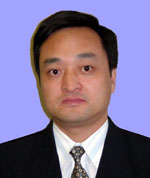 教授
教授
联系方式:
地址:上海市东安路130号复旦大学医学院西园7号楼107室
电子邮件:huangzl@fudan.edu.cn
电话:021-54237043
复旦大学特聘教授、博士生导师,基础医学院副院长、药理学系主任。1999年在日本留学获博士学位,任日本学术振兴会JSPS博士后、大阪生命科学研究所研究员,研究副部长;2005年12月加盟复旦大学。获国家杰出青年科学基金、上海市领军人才、上海市优秀学科带头人称号。
学会兼职:1) 中国睡眠研究会睡眠生理和药理专委会主任委员、上海市药学会药理专业委员会副主任委员、中国中西医结合学会生物节律专业委员会副主任委员、中国药理学会理事、中国神经科学会理事、日本睡眠学会评议员。
学术期刊任职:(1)副主编:《Frontier in Neuroscience》(SCI)、《Sleep and Breathing》(SCI)、《中国临床药理学与治疗学》和《世界睡眠医学杂志》;(2)编委或常务编委:《Acta Pharmacol Sin》(SCI)、《药学学报》、《中国药理学通报》、《中药药理与临床》、《四川精神卫生》、《神经药理学》和《生物物理学报》等。
研究方向
分子行为药理学、睡眠与失眠机制,镇静催眠药物开发。
招生专业
神经精神药理学、神经生物学
基金项目
国家自然科学基金重点项目,重点国际合作,国家杰出青年科学基金、国家新药创制“重大科技专项”、国家基础研究973、上海市领军人才和上海市优秀学科带头人计划,重点攻关及重点项目等课题。国内、外制药企业合作研究项目等。
研究工作
从基因到行为,研究组胺能神经和基底前脑调节睡眠觉醒的神经网络机制;发现了有效调控组胺能神经的内源性物质与作用机制;提出了下丘脑睡眠觉醒调节的跷跷板模型;纠正了睡眠界长期认为咖啡因促觉醒作用由腺苷A1受体介导的错误观点,发现A2A受体是睡眠觉醒调节的重要受体。获日本睡眠学会“优秀研究奖”和中国医师协会“中国睡眠研究杰出贡献奖”。
以中、英、日三种文字发表研究论文与综述150多篇,其中SCI杂志收录100篇,包括Nature Neuroscience, Light: Science & Applications, Nature Communications, PLos Biology,PNAS,eLife, Neuropsychopharmacology,Journal of Neuroscience等国际著名学术期刊,2014-2017年连续上榜爱思唯尔(Elsevier)发布的中国学术论文高被引学者榜单。应邀为Trends Neurosci, Prog Neurobiol等杂志撰写综述,为PNAS等20个SCI杂志审稿。
获奖
获教育部高等学校科学研究优秀成果奖(自然科学)、日本睡眠学会“优秀研究奖”和中国医师协会“中国睡眠研究杰出贡献奖”等。
代表论文
Luo YJ#, Li YD#, Wang L#, Yang SR, Yuan XS, Wang J, Cherasse Y, Lazarus M, Chen JF, Qu WM, and Huang ZL*. Nucleus accumbens controls wakefulness by a subpopulation of neurons expressing dopamine D1 receptors.Nature Communications, 2018 Apr 20;9(1):1576. doi: 10.1038/s41467-018-03889-3.
Wu YE, Enoki R*, Oda Y, Huang ZL*, et al. Ultradian Calcium Rhythms in the Paraventricular Nucleus and Subparaventricular Zone in the Hypothalamus. Proc Natl Acad Sci USA. 2018; 115(40):E9469-E9478. doi: 10.1073/pnas.1804300115.
Yang SR*, Hu ZZ, Luo YJ, Zhao YN, Sun HX, Yin D, Wang CY, Yan YD, Wang DY, Yuan XS, Ye CB, Guo W, Qu WM, Cherasse Y, Lazarus M, Ding YQ, Huang ZL*. The rostromedial tegmental nucleus is essential for non-rapid eye movement sleep. PLoS Biology, 2018 Apr 13;16(4):e2002909. doi: 10.1371/journal.pbio.2002909.
Oishi Y#, Xu Q#, Wang L#, Zhang BJ, Takahashi K, Takata Y, Luo YJ, Cherasse Y, Schifmann S, de Kerchove d'Exaerde A, Urade Y, Qu WM, Huang ZL*, and Lazarus M*. Slow-wave sleep is controlled by a subset of nucleus accumbens core neurons in mice. Nature Communications, 2017 Sep 29;8(1):734. doi: 10.1038/s41467-017-00781-4.
Yuan XS#, Wang L#, Dong H#, Qu WM, Yang SY, Cherasse Y, Lazarus M, Schifmann S, de Kerchove d'Exaerde A, Li RX* and Huang ZL*. Striatal adenosine A2A receptor neurons control active-period sleep via parvalbumin neurons in external globus pallidus. eLife, 2017, 2017 Oct 12;6. pii: e29055. doi: 10.7554/eLife.29055.
Zhang Z#, Wang HJ#, Wang DR, Qu WM* and Huang ZL*.Red light alters sleep-wake behavior at intensities above 10 lx in mice. Light: Science & Applications. 2017, DIO:10.1038/lsa.2016.231. (IF: 13.6).
Oishi Y, Huang ZL*,et al. Adenosine in the tuberomammillary nucleus inhibitsthe histaminergic system via A1 receptors andpromotes non-rapid eye movement sleep. Proc Natl Acad Sci USA, 2008, 105(50):19992-19997.
Huang ZL, Mochizuki T, Qu WM, Hong ZY, Watanabe T, Urade Y and Hayaishi O. Altered sleep-wake characteristics and lack of arousal response to H3 receptor antagonist in histamine H1 receptor knockout mice. Proc Natl Acad Sci USA 2006, 103(12): 4687-4692.
Huang ZL, Qu WM, Eguchi, N, Chen JF, Schwarzschild MA, Fredholm BB, Urade Y and Hayaishi O. Adenosine A2A, but not A1, receptors mediate the arousal effect of caffeine. Nat Neurosci 2005; 8(7): 858-859.
Huang ZL, QuWM, LiWD, MochizukiM, EguchiN, WatanabeT, UradeY and HayaishiO. Arousal effect of orexin A depends on activation of the histaminergic system. Proc Natl Acad Sci USA2001; 98(17): 9965-9970.
